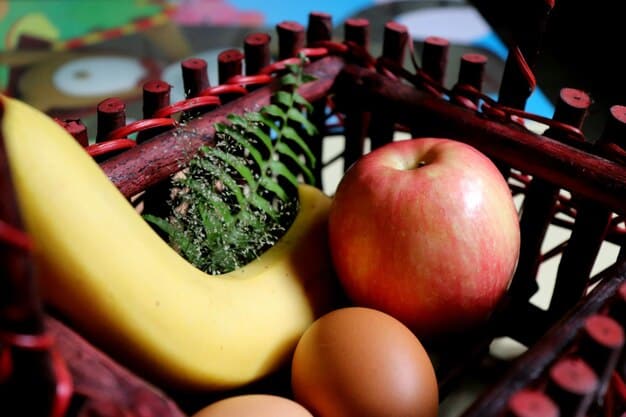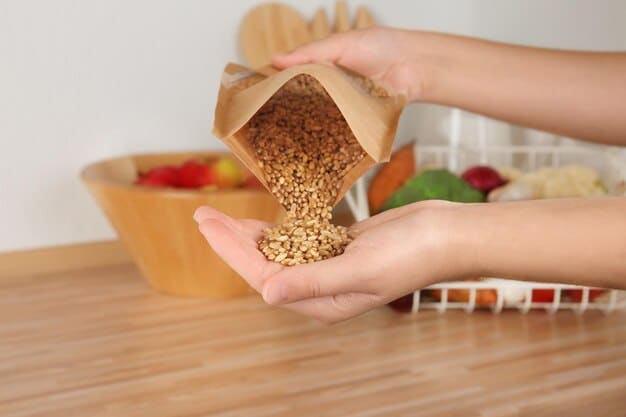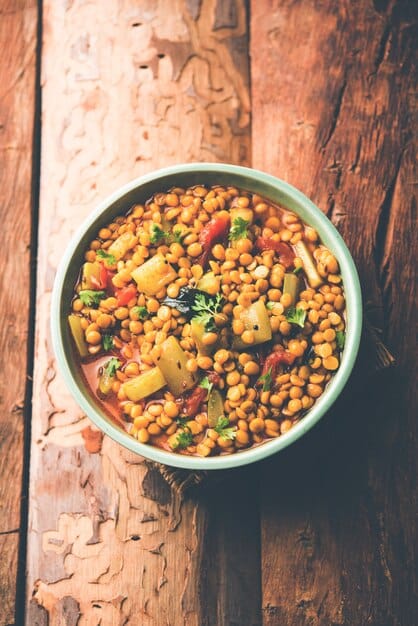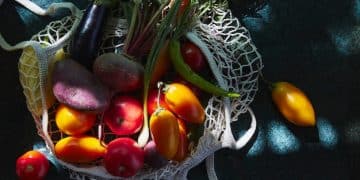5 Healthy Eating Swaps to Save $50 on Groceries in 2025

Achieving significant savings on grocery bills while maintaining a healthy diet is feasible by strategically implementing smart, budget-friendly food substitutions. This guide outlines five practical healthy eating swaps that can collectively save a household over $50 monthly on groceries by 2025, without compromising nutritional value or taste.
In an era where every penny counts and healthy living is a priority, finding ways to merge these two objectives can seem like a daunting task. However, the good news is that it’s entirely possible to eat well without breaking the bank. This article delves into 5 Healthy Eating Swaps to Save $50 a Month on Groceries in 2025, offering practical, actionable advice that can lead to significant savings while enhancing your dietary intake.
The Intersection of Health and Budget: Why Smart Swaps Matter
The rising cost of living, particularly food prices, has put a strain on many household budgets. Simultaneously, there’s a growing awareness about the importance of nutrition for overall well-being. This creates a unique challenge: how to afford healthy food without sacrificing financial stability. The answer lies in making informed, strategic swaps.
Understanding the value of healthy eating extends beyond just physical health; it impacts mental clarity, energy levels, and even long-term healthcare costs. Conversely, financial stress can negatively affect health. Therefore, finding a balance where health-conscious choices also support financial goals is paramount. Smart swaps aren’t about deprivation; they’re about optimization – getting more nutritional bang for your buck.
The Economic Imperative for Mindful Grocery Shopping
Current economic trends indicate a continued upward pressure on food prices. This makes proactive budgeting and strategic shopping more important than ever. By re-evaluating our default grocery choices and embracing alternatives, we can mitigate the impact of inflation on our food expenses while still ensuring a nutritious diet. It’s about empowering consumers to take control of their food budget without compromising on quality or health.
- Identify high-cost, low-nutrient items in your current shopping habits.
- Explore seasonal and local produce for better prices and freshness.
- Understand unit pricing to compare different product sizes effectively.
Moreover, the environmental impact of food choices is becoming a significant factor. Opting for plant-based alternatives or less processed foods often aligns with both health and sustainability goals, offering a double benefit forconscious consumers. This holistic approach to grocery shopping not only saves money but also contributes to a healthier planet.
The journey to saving on groceries while eating healthy begins with a shift in mindset—from reactive buying to proactive meal planning and ingredient selection. Each swap we discuss is designed to be accessible, effective, and easily integrated into daily routines, proving that healthy eating doesn’t have to be a luxury.
Swap 1: Processed Snack Bars to Homemade Energy Bites
Processed snack bars, often marketed as healthy options, can be surprisingly expensive and laden with hidden sugars and unhealthy fats. They offer convenience but at a premium, both for your wallet and your health. Making the switch to homemade energy bites is a game-changer, providing superior nutrition at a fraction of the cost.
Homemade energy bites typically consist of whole, unprocessed ingredients like oats, nuts, seeds, dried fruit, and a natural sweetener such as dates or maple syrup. This not only allows you to control the quality of ingredients but also to customize flavors and nutritional profiles to your liking. The cost savings add up quickly, especially if you rely on snack bars daily.
Cost and Health Benefits of Homemade Options
A single store-bought snack bar can cost anywhere from $1.50 to $3.00. If you consume one daily, that’s $45 to $90 a month just on snack bars. The ingredients for homemade energy bites, bought in bulk, can yield multiple batches for a fraction of that price. For instance, a large bag of oats, a tub of peanut butter, and a box of dates can make dozens of bites for less than $20.
Nutritionally, homemade bites are usually higher in fiber and healthy fats, lower in added sugars, and free from artificial additives. They provide sustained energy, help regulate blood sugar, and contribute essential micronutrients. This swap supports weight management, boosts digestive health, and reduces reliance on highly processed foods, making it a powerful step towards better health and savings.
- Reduced sugar intake and artificial ingredients.
- Increased fiber and healthy fats for satiety.
- Significant monthly savings, potentially $30 or more.
The minimal preparation time required for energy bites, often just 15-20 minutes for a week’s supply, makes this a feasible swap for even the busiest individuals. They are portable, delicious, and satisfy cravings effectively, making them an ideal on-the-go snack or pre/post-workout fuel. This simple change alone can put a noticeable dent in your grocery bill.
Swap 2: Premium Packaged Grains to Bulk Whole Grains
Pre-packaged and instant versions of grains like quinoa, brown rice, and oats often come with a hefty markup due to convenience and branding. While convenient, this premium pricing adds up considerably over time. Transitioning to buying whole grains in bulk from health food stores or the bulk bins of larger supermarkets offers substantial savings and often superior quality.
Buying grains in bulk means you purchase only the quantity you need, reducing waste and allowing for greater flexibility in your meal planning. It also removes the cost associated with individual packaging. For example, a small box of instant oatmeal can be disproportionately expensive compared to buying rolled oats in a large bag, which can last for months.
Maximizing Savings with Bulk Purchases
The price difference between packaged and bulk grains can be astounding. A pound of pre-cooked, microwavable quinoa might cost $4-$5, whereas a pound of dry, bulk quinoa could be $2-$3. Over a month, if you’re regularly consuming these grains, the savings can easily hit $10-$15.
Additionally, bulk grains often offer more variety, allowing you to experiment with different types like farro, barley, or millet, which are nutritious and budget-friendly. Cooking them takes a little more time than instant versions, but the preparation is simple and can be done in larger batches for meal prepping. This shift encourages more home cooking and less reliance on processed, ready-to-eat options.
Investing in a few airtight containers to store your bulk grains will ensure freshness and longevity, further maximizing your savings and reducing food waste. This small upfront investment pays dividends in the long run, making healthy eating more accessible and affordable.

Embracing bulk grains also aligns with eco-friendly practices by reducing packaging waste. This mindful approach to grocery shopping benefits both your wallet and the planet, proving that healthier choices can also be more sustainable. It’s a win-win strategy for the discerning consumer.
Swap 3: Sugary Drinks to Infused Water or Unsweetened Tea
Sugary sodas, fruit juices (even 100% juice can contain high sugar content), and specialty coffee drinks are significant contributors to both unhealthy diets and inflating grocery bills. They offer little nutritional value beyond calories and sugar, and their cost per serving is often surprisingly high. Replacing these with infused water or unsweetened tea is a simple yet powerful swap.
Tap water is virtually free, and infusing it with fruits, vegetables, and herbs—like lemon, cucumber, mint, or berries—creates a refreshing, flavorful, and hydrating beverage without the added sugars or artificial ingredients. Similarly, brewing your own unsweetened tea using tea bags or loose-leaf tea is dramatically cheaper than buying bottled versions or café-bought lattes.
Financial and Health Dividends
Consider the cost of a daily soda or a large specialty coffee, which can range from $2 to $5. Over a month, this adds up to $60-$150. Even if you’re only swapping out a few drinks a week, the savings are substantial. A box of tea bags costs a few dollars and can make dozens of servings. Fruit for infused water can be purchased during sales or used from produce that might otherwise go to waste.
From a health perspective, cutting out sugary drinks is one of the most effective ways to reduce calorie intake, improve dental health, and lower the risk of chronic diseases such as type 2 diabetes and heart disease. Infused water and unsweetened tea provide hydration and antioxidants without the negative consequences of excessive sugar consumption. This swap isn’t just about saving money; it’s about making a profound positive impact on long-term health.
- Eliminate empty calories and added sugars from your diet.
- Improve hydration and overall well-being.
- Save $20-$40 monthly by ditching expensive beverages.
Making infused water or brewing tea at home requires minimal effort and can become a pleasant daily ritual. Investing in a good reusable water bottle or a tea infuser further enhances the experience and commitment to this healthy, money-saving habit. This swap demonstrates how small changes can lead to large returns, both financially and health-wise.
Swap 4: Pre-Cut Fruits and Vegetables to Whole Produce
Pre-cut and pre-washed fruits and vegetables are undoubtedly convenient. However, this convenience comes at a steep price premium. A bag of pre-chopped bell peppers or a container of melon chunks can cost two to three times more per pound than their whole, unprepared counterparts. Making the switch to buying whole produce and doing the chopping yourself is a simple yet effective way to save money.
While it requires a few extra minutes of preparation time, the financial benefits are significant. Moreover, buying whole produce often means you’re getting fresher items that haven’t been exposed to as much processing, which can impact their nutritional content and shelf life. You also have more control over the size and shape of your cuts, tailoring them to your specific culinary needs.
The Real Value of Preparing Your Own Produce
The difference in cost can be quite striking. For example, a whole pineapple might cost $3-$4, while a small plastic container of pre-cut pineapple chunks could be $5-$6. If you regularly buy several types of pre-cut produce each week, you could easily be spending an extra $15-$25 a month. Learning basic knife skills can turn this small chore into a quick, routine task.
Beyond the savings, preparing your own produce reduces plastic waste associated with pre-packaged items, contributing to environmental sustainability. It also allows you to wash your produce thoroughly, ensuring cleanliness. This swap encourages a deeper connection with your food and enhances your cooking skills, making meal preparation a more engaging and cost-effective process.
Consider dedicating a specific time each week, perhaps after your grocery trip, to wash, chop, and store your produce. This “prep session” can save time during busy weekdays and ensure you always have healthy ingredients ready to go, making it easier to stick to your healthy eating goals. This small investment of time yields considerable financial and health returns.
Swap 5: Conventional Meat to Plant-Based Proteins (Partially)
Meat, especially red meat and certain poultry cuts, can be one of the most expensive components of a grocery bill. While not advocating for a complete elimination of meat for everyone, strategically incorporating more plant-based proteins into your diet can lead to significant savings while offering numerous health benefits. This “partial swap” is about balance and conscious consumption.
Plant-based proteins like lentils, beans, chickpeas, tofu, and tempeh are incredibly versatile, nutritious, and far more budget-friendly than most meat options. They are excellent sources of fiber, vitamins, and minerals, and often contain less saturated fat and cholesterol than animal proteins. Regularly substituting one or two meat-based meals a week with plant-based alternatives can yield substantial savings.
The Dual Benefits of Diversifying Protein Sources
A pound of ground beef might cost $5-$7, whereas a bag of dry lentils or beans (which can yield multiple meals) could be $1-$3. Even canned beans or lentils, while slightly more expensive than dry, are still considerably cheaper per serving than meat. If you replace just two meat meals a week for a month, the savings could easily reach $10-$20 or more.
From a health perspective, increasing plant-based protein intake is associated with a lower risk of heart disease, type 2 diabetes, certain cancers, and improved digestive health. It also diversifies your nutrient intake, providing different arrays of vitamins and minerals. This swap is not about going vegetarian or vegan, but about incorporating more plant power into your diet in a flexible and sustainable way.

Experiment with recipes that feature beans in chili or tacos, lentils in soups or curries, and chickpeas in salads or stir-fries. Many traditional cuisines around the world heavily rely on legumes as their primary protein source, offering a vast array of delicious and satisfying dishes. This dietary diversification is both financially savvy and nutritionally enriching.
Implementing Your Swaps: A Strategic Approach for 2025
Successfully integrating these healthy eating swaps into your routine requires a strategic approach. It’s not about making drastic changes overnight, but rather about gradual, sustainable shifts that become second nature. Start with one or two swaps that feel most manageable, master them, and then gradually introduce others. This incremental method prevents overwhelm and fosters long-term adherence.
Meal planning is a crucial tool in this process. By planning your meals and snacks for the week, you can consciously incorporate these swaps, ensure you have the necessary ingredients, and avoid impulse purchases of expensive or unhealthy alternatives. Create a grocery list based on your meal plan, sticking to it as much as possible to prevent budget creep.
Building Sustainable Healthy Habits
One effective strategy is to dedicate specific days for grocery shopping and meal preparation. For example, a Sunday afternoon could be set aside for a trip to the supermarket and then an hour or two for chopping vegetables, cooking a batch of grains, or making energy bites. This upfront investment of time saves precious minutes during the busy week and ensures healthy options are always within reach.
Furthermore, track your savings. Seeing the tangible impact of these swaps on your grocery bill can be incredibly motivating. You might find that you’re saving more than the estimated $50, reinforcing your commitment to these healthier, more economical eating habits. This quantitative feedback loop solidifies positive behavioral changes.
- Start small: implement one swap at a time.
- Plan meals around budget-friendly, whole ingredients.
- Batch cook and prep to save time during the week.
Remember, consistency is key. There might be weeks where you stray, and that’s perfectly normal. The goal is progress, not perfection. Keep refining your approach, discovering new recipes, and enjoying the benefits of a healthier body and a healthier bank account. By 2025, these small changes will have compounded into significant financial and wellness gains.
Beyond the Swaps: Maximizing Your Grocery Savings
While the five healthy eating swaps are powerful tools for saving money and improving health, there are additional strategies that can further amplify your grocery budget. Thinking holistically about your food procurement and consumption habits can unlock even greater savings, creating a truly optimized approach to healthy eating on a budget.
Consider shopping at different types of stores. Farmers’ markets often offer seasonal produce at competitive prices, especially towards the end of the day. Discount grocery stores or ethnic markets can be treasure troves for spices, bulk items, and unique ingredients at lower costs. Combining shopping trips to these different venues can yield a broader selection and better prices.
Advanced Strategies for Frugal Foodies
Embracing seasonal eating is another highly effective tactic. Produce that is in season locally is typically more abundant, fresher, and therefore less expensive. Planning your meals around seasonal availability not only saves money but also ensures you’re eating produce at its peak flavor and nutritional value. This also supports local farmers and reduces your carbon footprint.
Minimizing food waste is arguably one of the most impactful ways to save money on groceries. Uneaten food represents wasted money. Develop habits like using leftovers creatively, freezing excess produce or cooked meals, and understanding proper food storage techniques to extend shelf life. A significant portion of household food waste is avoidable with careful planning and utilization.
Finally, avoid shopping when hungry, as this often leads to impulsive and unnecessary purchases. Always go with a list and stick to it. Taking a few extra minutes to compare unit prices on different brands or sizes can also reveal unexpected savings. These habits, combined with the core swaps, create a robust framework for managing your food budget effectively.
| Key Swap | Brief Description |
|---|---|
| 🍪 Homemade Energy Bites | Replace expensive processed snack bars with DIY, nutrient-rich alternatives. |
| 🍚 Bulk Whole Grains | Opt for bulk purchases of oats, rice, and quinoa over pre-packaged options. |
| 💧 Infused Water/Unsweetened Tea | Eliminate costly sugary drinks by choosing homemade flavored water or tea. |
| 🍏 Whole Over Pre-Cut Produce | Buy whole fruits and vegetables and prepare them yourself to save significantly. |
Frequently Asked Questions About Healthy Eating on a Budget
Saving $50 a month is very realistic, and often achievable. Each swap targets a common area of overspending in grocery budgets. Individual savings will vary based on current habits and prices, but by combining these five strategies, many households can easily exceed this target. Consistency and mindful application are key to reaching this goal.
Not at all; in fact, they can enhance it. Homemade energy bites allow for custom flavors, bulk grains offer diverse culinary options, and infused water provides refreshing variety. While some initial adjustments might be needed, many people find preparing their own food more satisfying and discover new favorite healthy dishes they genuinely enjoy.
Start small and gradually build up. Choose one swap that feels easiest to implement first, like making infused water daily or trying one plant-based meal a week. Once that becomes a habit, introduce another swap. This incremental approach prevents feeling overwhelmed and makes the changes more sustainable in the long run.
Absolutely. Many budgeting apps like Mint or YNAB (You Need A Budget) allow you to categorize and track grocery expenses. Specific grocery list apps can help you stick to your plan and compare prices. Keeping a simple spreadsheet of your weekly grocery spending and noting the impact of your swaps can also be highly effective for tracking progress.
Combining different plant-based proteins throughout the day generally ensures complete protein intake. For instance, pairing legumes (beans, lentils) with grains (rice, quinoa) forms a complete protein. Most plant-based foods contain various amino acids, and a diverse diet with multiple plant sources will typically provide all essential amino acids over the course of a day.
Conclusion: A Healthier, Happier, and More Frugal Future
The journey to a healthier lifestyle doesn’t have to be paved with exorbitant costs. By thoughtfully integrating these five healthy eating swaps into your daily routine, you have the power to significantly reduce your grocery expenses, potentially saving over $50 a month by 2025, while simultaneously elevating your nutritional intake.
These strategies empower you to make conscious choices that benefit both your physical well-being and your financial health. They demonstrate that convenience sometimes comes at too high a price, and that a little effort in the kitchen can yield substantial rewards. Embrace these changes, experiment with new recipes, and watch as your grocery bill shrinks and your health flourishes, leading to a more sustainable and fulfilling lifestyle.





